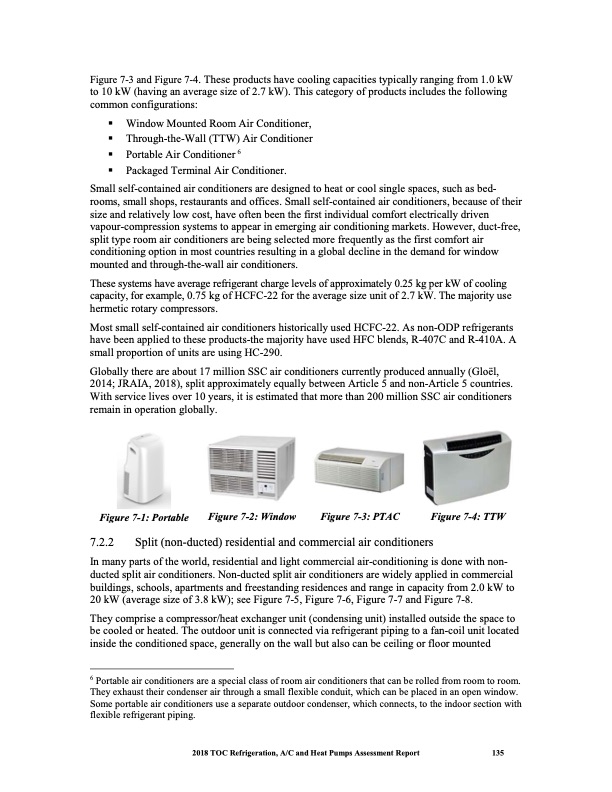
PDF Publication Title:
Text from PDF Page: 148
Figure 7-3 and Figure 7-4. These products have cooling capacities typically ranging from 1.0 kW to 10 kW (having an average size of 2.7 kW). This category of products includes the following common configurations: Window Mounted Room Air Conditioner, Through-the-Wall (TTW) Air Conditioner Portable Air Conditioner 6 Packaged Terminal Air Conditioner. Small self-contained air conditioners are designed to heat or cool single spaces, such as bed- rooms, small shops, restaurants and offices. Small self-contained air conditioners, because of their size and relatively low cost, have often been the first individual comfort electrically driven vapour-compression systems to appear in emerging air conditioning markets. However, duct-free, split type room air conditioners are being selected more frequently as the first comfort air conditioning option in most countries resulting in a global decline in the demand for window mounted and through-the-wall air conditioners. These systems have average refrigerant charge levels of approximately 0.25 kg per kW of cooling capacity, for example, 0.75 kg of HCFC-22 for the average size unit of 2.7 kW. The majority use hermetic rotary compressors. Most small self-contained air conditioners historically used HCFC-22. As non-ODP refrigerants have been applied to these products-the majority have used HFC blends, R-407C and R-410A. A small proportion of units are using HC-290. Globally there are about 17 million SSC air conditioners currently produced annually (Gloёl, 2014; JRAIA, 2018), split approximately equally between Article 5 and non-Article 5 countries. With service lives over 10 years, it is estimated that more than 200 million SSC air conditioners remain in operation globally. Figure 7-1: Portable Figure 7-2: Window Figure 7-3: PTAC Figure 7-4: TTW 7.2.2 Split (non-ducted) residential and commercial air conditioners In many parts of the world, residential and light commercial air-conditioning is done with non- ducted split air conditioners. Non-ducted split air conditioners are widely applied in commercial buildings, schools, apartments and freestanding residences and range in capacity from 2.0 kW to 20 kW (average size of 3.8 kW); see Figure 7-5, Figure 7-6, Figure 7-7 and Figure 7-8. They comprise a compressor/heat exchanger unit (condensing unit) installed outside the space to be cooled or heated. The outdoor unit is connected via refrigerant piping to a fan-coil unit located inside the conditioned space, generally on the wall but also can be ceiling or floor mounted 6 Portable air conditioners are a special class of room air conditioners that can be rolled from room to room. They exhaust their condenser air through a small flexible conduit, which can be placed in an open window. Some portable air conditioners use a separate outdoor condenser, which connects, to the indoor section with flexible refrigerant piping. 2018 TOC Refrigeration, A/C and Heat Pumps Assessment Report 135PDF Image | Heat Pumps Technical Options

PDF Search Title:
Heat Pumps Technical OptionsOriginal File Name Searched:
RTOC-assessment-report-2018_0.pdfDIY PDF Search: Google It | Yahoo | Bing
CO2 Organic Rankine Cycle Experimenter Platform The supercritical CO2 phase change system is both a heat pump and organic rankine cycle which can be used for those purposes and as a supercritical extractor for advanced subcritical and supercritical extraction technology. Uses include producing nanoparticles, precious metal CO2 extraction, lithium battery recycling, and other applications... More Info
Heat Pumps CO2 ORC Heat Pump System Platform More Info
| CONTACT TEL: 608-238-6001 Email: greg@infinityturbine.com | RSS | AMP |